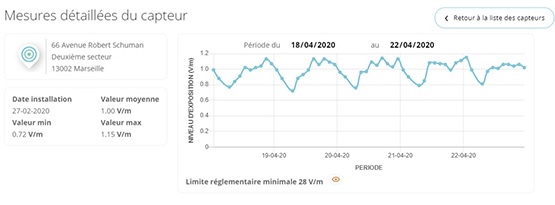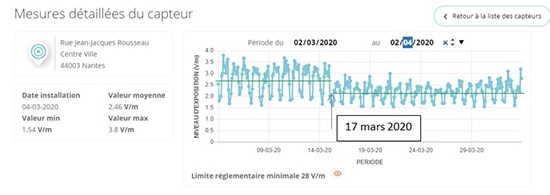04/30/2020
(Auto translated from French)
The National Frequency Agency (ANFR) sets up autonomous sensors to measure exposure in Marseille and Nantes in order to monitor its development, in particular in anticipation of the commercial opening of 5G in late 2020. In operation since the beginning of March , these sensors already show fluctuations in exposure between day and night, as well as variations linked to the confinement period.
As part of its missions to monitor public exposure to electromagnetic waves, the ANFR, in collaboration with the municipalities of Marseille and Nantes, installed autonomous sensors in the city center, near antennas 5G currently under test, in order to monitor the evolution of exposure. These broadband sensors, manufactured by the EXEM laboratory, measure around ten times a day the exposure to electromagnetic waves emitted by all the equipment in the bands ranging from 80 MHz to 6 GHz. This range of waves includes FM radio, digital terrestrial television, Wi-Fi or all types of mobile telephony.
Marseille and Nantes are the first cities to have installed these sensors, which have been active since the beginning of March. They are located high up and placed about 150 meters from an experimental 5G antenna. Measurements are made periodically, over a period of 6 minutes, at different times of the day and night. In order to detect fluctuations in exposure, these sensors measure the exposure levels every 2 hours approximately. These values will, from today, be published in real time on the ANFR website .
Today, 5G traffic remains low and corresponds only to tests. The sensors therefore mainly reflect the exposure due to 2G, 3G or 4G networks. They will make it possible to analyze the impact of 5G on the overall exposure of the public during this experimental phase, then on the occasion of the first commercial deployments envisaged from the end of 2020.
The values communicated by these sensors already show that the overall exposure to radio waves varies regularly between day and night: in the example presented below (fig. 1), the values measured during at night are less than 1 V / m and can go down to around 0.8 V / m. Then they go up during the day to reach values close to 1.2 V / m. This level remains generally stable during the day.

These sensors also show that the confinement led from 17 March to a local drop in exposure . For example, in the table in the appendix (fig. 2), from the first day of confinement, a drop of 21% appears on one of the sensors installed in Nantes. This phenomenon is also visible in the curve presented in the appendix (fig. 3).


New cities hosting 5G experiments will benefit in the coming weeks from the installation of sensors and will enrich the data already listed by the ANFR.
